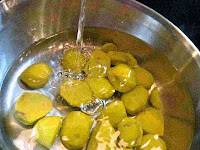<Ingredients>
1 large or 2 small kuchinashi dried gardenia fruit
2 tbsp rice vinegar
100-120 g granulated sugar
50 g brown sugar
2 tbsp mirin
<Directions>
1.
Bring plenty of water to boil, remove from heat, and soak kuri for 30 minutes. (By the time the water cools enough to pick out a chestnut with your hand, the tough outer skin should be soft.)
Cut the bottom of kuri, and peel outer skin.
Peel inner skin.
Immediately soak peeled kuri in water.
2.
Cut kuchinashi in half.
3.
In a pot, place kuri and water to cover.
Add rice vinegar and kuchinashi, and bring to boil on medium heat.
When boiling, reduce heat to low, and simmer until bamboo skewer goes through smoothly, about 30-40 minutes.
Add water as necessary to keep kuri immersed while simmering. Remove from heat, and let cool.
4.
Drain, add cold water to cover, and let sit for 30 minutes.
Change water two or three times while soaking.
5.
In a pot, put kuri, just enough water to cover (approx. 350-400cc) and 1/3 of sugar, and bring to boil on medium heat after placing an otoshibuta drop cover.
Once boiling, reduce heat to low, and simmer for 20 minutes. If foam appears on surface, skim.
6.
Add 1/2 of remaining sugar, cover with otoshibuta, and simmer for 20 minutes.
7.
Add remaining sugar and mirin, cover with otoshibuta, and simmer for 20 minutes.
8.
Remove from heat, and cool overnight.
Kuri no kanroni is ready.
<Notes>
 You can store kuri no kanroni as is (in syrup) in a container in the fridge for several weeks or freeze. I freeze kuri no kanroni by wrapping them in plastic film and then placing them in a Ziploc bag. They can be frozen in syrup, too. Some people use the syrup from making kuri no kanroni in kuri kinton, so they also save the syrup (freeze in a separate container or together with chestnuts).
You can store kuri no kanroni as is (in syrup) in a container in the fridge for several weeks or freeze. I freeze kuri no kanroni by wrapping them in plastic film and then placing them in a Ziploc bag. They can be frozen in syrup, too. Some people use the syrup from making kuri no kanroni in kuri kinton, so they also save the syrup (freeze in a separate container or together with chestnuts).
- Rice vinegar helps prevent chestnuts from crumbling while simmering.
- To get chestnuts to hold their shape better (firm up), soak peeled chestnuts in water and yaki myoban burnt alum (1 tsp yaki myoban per 1000 cc water) for 30 minutes to overnight. Then soak chestnuts in cold water for 30 minutes to several hours, and continue with Process 3 above. When yaki myoban is used, rice vinegar is not needed. Yaki myoban also helps to retain the yellow color.
- Kuchinashi dried gardenia fruit are added to color chestnuts, but they are optional. Kuchinashi is available at Chinese grocery stores or herbal medicine shops in the US.
- If mirin is not available, honey works. (Honey is much, much sweeter than mirin for the same amount.)
(Last updated: November 12, 2016)






















Hi. Thank you for posting. I made it and it has the smell of wine. Pls teach me is this ok? I have never eaten it before.
ReplyDeleteHi Lucie,
ReplyDeleteThank you for the interesting question. I have never sensed the wine smell with this, so I don’t know where it comes from. Possibly from gardenia fruits or vinegar? I will let you know if find anything.
I have just read again your recipes. I did not put kuri in the fridge. I will try to made again. Thank you.
Delete